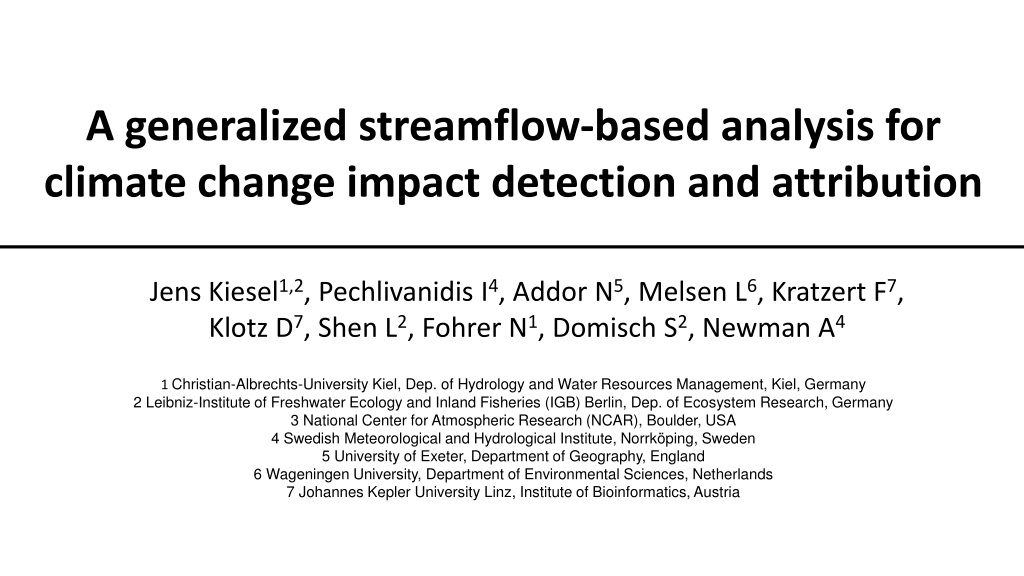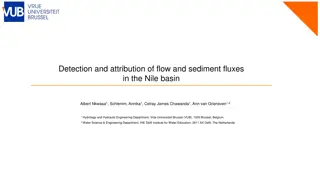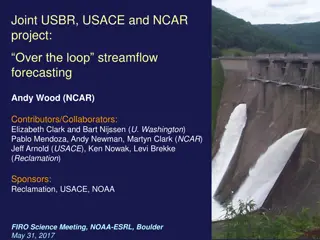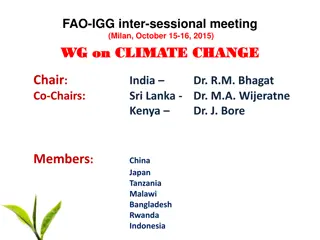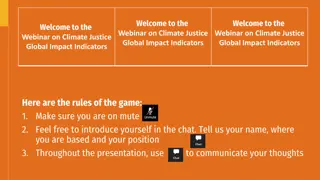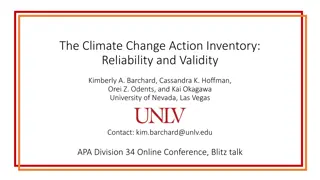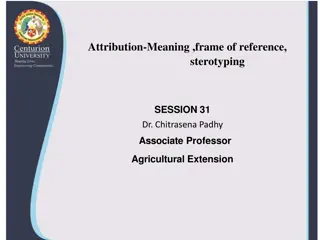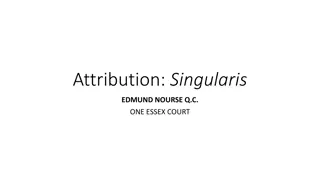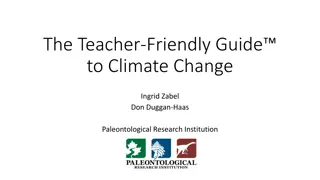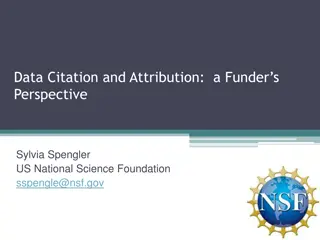Streamflow-Based Analysis for Climate Change Impact Detection and Attribution
This study focuses on detecting and attributing climate change impacts using a multi-basin, multi-model approach. It utilizes the CAMELS dataset, including observed data from 671 gauges across the USA, to analyze streamflow changes and seasonality shifts. The methodology involves updating datasets, obtaining hydrological models, and running hindcasted climate change scenarios to compare simulated and observed streamflow patterns.
Download Presentation

Please find below an Image/Link to download the presentation.
The content on the website is provided AS IS for your information and personal use only. It may not be sold, licensed, or shared on other websites without obtaining consent from the author. Download presentation by click this link. If you encounter any issues during the download, it is possible that the publisher has removed the file from their server.
E N D
Presentation Transcript
A generalized streamflow-based analysis for climate change impact detection and attribution Jens Kiesel1,2, Pechlivanidis I4, Addor N5, Melsen L6, Kratzert F7, Klotz D7, Shen L2, Fohrer N1, Domisch S2, Newman A4 1 Christian-Albrechts-University Kiel, Dep. of Hydrology and Water Resources Management, Kiel, Germany 2 Leibniz-Institute of Freshwater Ecology and Inland Fisheries (IGB) Berlin, Dep. of Ecosystem Research, Germany 3 National Center for Atmospheric Research (NCAR), Boulder, USA 4 Swedish Meteorological and Hydrological Institute, Norrk ping, Sweden 5 University of Exeter, Department of Geography, England 6 Wageningen University, Department of Environmental Sciences, Netherlands 7 Johannes Kepler University Linz, Institute of Bioinformatics, Austria
The general idea... ...is, to detect and attribute climate change impacts for the historical period in a multi-basin multi-model study
The Catchment Attributes and Meteorology for Large Sample Studies (CAMELS) dataset High-quality observed data for 671 gauges across all climate and ecoregions of the USA Climate, geology, hydrology, soil, topography and vegetation attributes lumped for each basin Mostly headwater basins (4 25,000 km , av. 800km ) with little anthropogenic influence Ready-to use dataset for multiple hydrological models (VIC, HBV, SAC, LSTM) PCP (mm yr-1) Newman et al. (2015) HESS
The steps needed to get this to work... Update CAMELS dataset: - extend streamflow time series, update meteorological dataset (daymet v2 to daymet v4) Obtain behavioural hydrological models for the observed baseline - 2000-2014 calibration and 1985-1999 validation - 5-step evaluation criteria (Krysanova et al. 2018 HSJ) Obtain hindcasted climate change: - download ISIMIP 3a counterfactual (50x50km: gswp3-w5e5) - download ISIMIP 3b CMIP6 (50x50km: gfdl-esm, ipsl-cm6a, mpi-esm, mri-esm, ukesm) - (ISIMIP 1km, LOCA climate change 32 downscaled CMIP5 models) Run hindcasted data through the behavioural models - calculate CAMELS spatial basin averages for each climate model dataset per time step - run bias adjusted (1985-2014) and non-bias adjusted data through the models Identify simulated streamflow change from hindcast vs observation: - detection of the climate change signal in all streamflow time series
Observed streamflow change in seasonality (1950-1980, 1990-2020) 441 basins remaining (<5% gaps)
The steps needed to get this to work... Update CAMELS dataset: - extend streamflow time series, update meteorological dataset (daymet v2 to daymet v4) Obtain behavioural hydrological models for the observed baseline - 2000-2014 calibration and 1985-1999 validation - 5-step evaluation criteria (Krysanova et al. 2018 HSJ) Obtain hindcasted climate change: - download ISIMIP 3a counterfactual (50x50km: gswp3-w5e5) - download ISIMIP 3b CMIP6 (50x50km: gfdl-esm, ipsl-cm6a, mpi-esm, mri-esm, ukesm) - (ISIMIP 1km, LOCA climate change 32 downscaled CMIP5 models) Run hindcasted data through the behavioural models - calculate CAMELS spatial basin averages for each climate model dataset per time step - run bias adjusted (1985-2014) and non-bias adjusted data through the models Identify simulated streamflow change from hindcast vs observation: - detection of the climate change signal in all streamflow time series
Resources Servers available at IGB Berlin (climate data storage and processing) Servers available at NCAR (hydrological model runs) Many team members but the study is not embedded in a particular project... (time constraints) Problems, questions and constraints - due to observed streamflow we are restricted to the post 1950 time period - we will need to apply an adapted 5-step evaluation for the models - we use different observed climate data (not W5E5) and run an additional bias adjustment - ISIMIP 3a counterfactual: we can wait (correction issue GSWP3 vs 20CRv3) - ISIMIP 3a counterfactual 1km: it would be advantageous because the CAMELS basins are small (but probably 5km are sufficient as well)
